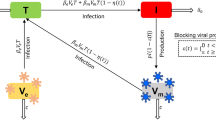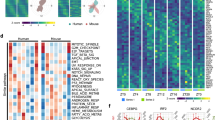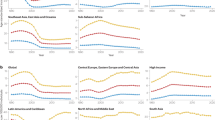Abstract
Lack of a small animal model of the human hepatitis C virus (HCV) has impeded development of antiviral therapies against this epidemic infection. By transplanting normal human hepatocytes into SCID mice carrying a plasminogen activator transgene (Alb-uPA), we generated mice with chimeric human livers. Homozygosity of Alb-uPA was associated with significantly higher levels of human hepatocyte engraftment, and these mice developed prolonged HCV infections with high viral titers after inoculation with infected human serum. Initial increases in total viral load were up to 1950-fold, with replication confirmed by detection of negative-strand viral RNA in transplanted livers. HCV viral proteins were localized to human hepatocyte nodules, and infection was serially passaged through three generations of mice confirming both synthesis and release of infectious viral particles. These chimeric mice represent the first murine model suitable for studying the human hepatitis C virus in vivo.
This is a preview of subscription content, access via your institution
Access options
Subscribe to this journal
Receive 12 print issues and online access
$259.00 per year
only $21.58 per issue
Buy this article
- Purchase on SpringerLink
- Instant access to full article PDF
Prices may be subject to local taxes which are calculated during checkout





Similar content being viewed by others
Accession codes
References
Sarbah, S. & Younossi, Z. Hepatitis C: An update on the silent epidemic. J. Clin. Gastro. 30, 125–143 (2000).
Choo, Q.L. et al. Isolation of a cDNA clone derived from a blood borne non-A non-B viral hepatitis genome. Science 244, 359–361 (1989).
Heckel, J., Sandgren, E., Degen, J., Palmiter, R. & Brinster, R. Neonatal bleeding in transgenic mice expressing urokinase-type plasminogen activator. Cell 62, 447–456 (1990).
Sandgren, E. et al. Complete hepatic regeneration after somatic deletion of an albumin-plasminogen activator transgene. Cell 68, 245–256 (1991).
Rhim, J., Sandgren, E., Degen, J., Palmiter, R. & Brinster, R. Replacement of diseased mouse liver by hepatic cell transplantation. Science 263, 1149–1152 (1994).
Petersen, J., Dandri, M., Gupta, S. & Rogler, C. Liver repopulation with xenogeneic hepatocytes in B and T cell-deficient mice leads to chronic hepadnavirus infection and clonal growth of hepatocellular carcinoma. Proc. Natl. Acad. Sci. USA 95, 310–315 (1998).
Brown, J. et al. A long-term hepatitis B viremia model generated by transplanting nontumorigenic immortalized human hepatocytes in Rag-2 deficient mice. Hepatology 31, 173–181 (2000).
Petersen, J. et al. Hepatocytes isolated from the adult human liver can repopulate the liver of uPA/Rag-2 mice and support hepatitis B virus infection and replication. Hepatology 30, 423A (1999).
Clement, B. et al. Long-term co-cultures of adult human hepatocytes with rat liver epithelial cells: Modulation of albumin secretion and accumulation of extracellular material. Hepatology 4, 373–380 (1984).
Rhim, J., Sandgren, E., Palmiter, R. & Brinster, R. Complete reconstitution of mouse liver with xenogeneic hepatocytes. Proc. Natl. Acad. Sci. USA 92, 4942–4946 (1995).
Schmid, C.W. Alu: Structure, origin, evolution, significance, and function of one-tenth of human DNA. Prog. Nucl. Acid Res. Mol. Biol. 53, 283–319 (1996).
Van Beveren, C., van Straaten, F., Galleshaw, J. & Verma, I. Nucleotide sequence of the genome of a murine sarcoma virus. Cell 27, 97–108 (1981).
Mellor, J., Haydon, G., Blair, C., Livingstone, W. & Simmonds, P. Low level or absent in vivo replication of hepatitis C virus and hepatitis G virus/GB virus C in peripheral blood mononuclear cells. J. Gen. Virol. 79, 705–714 (1998).
Lanford, R., Chavez, D., Chisari, F.W. & Sureau C. Lack of detection of negative-strand hepatitis C virus RNA in peripheral blood mononuclear cells and other extrahepatic tissues by the highly-specific rTth reverse transcriptase PCR. J. Virol. 69, 8079–8083 (1995).
Lanford, R., Sureau, C., Jacob, J., White, R. & Fuerst, T. Demonstration of in vitro infection of chimpanzee hepatocytes with hepatitis C virus using strand-specific RT/PCR. Virology 202, 606–614 (1994).
Brody, R. et al. Immunohistochemical detection of hepatitis C antigen by monoclonal antibody TORDJI-22 compared with PCR viral detection. Am. J. Clin. Path. 110, 32–37 (1998).
Ballet, F. et al. Isolation, culture and characterization of adult human hepatocytes from surgical liver biopsies. Hepatology 4, 849–854 (1984).
Dorko, K. et al. A new technique for isolating and culturing human hepatocytes from whole or split livers not used for transplantation. Cell Transplant. 3, 387–395 (1994).
Seglen, P. Preparation of isolated rat liver cells Meth. Cell. Biol. 13, 29–83 (1976).
Ryan, C., Carter, E., Jenkins, R. & Sterling, L. Isolation and long-term culture of human hepatocytes. Surgery 113, 48–54 (1993).
Zietkiewicz, E., Labuda, M., Sinnett, D., Glorieux, G. & Labuda, D. Linkage mapping by simultaneous screening of multiple polymorphic loci using Alu oligonucleotide-directed PCR. Proc. Natl. Acad. Sci. USA 89, 8448–8451 (1997).
Murphy, D., Willems, B. & Delage, G. Use of the 5′ noncoding region for genotyping hepatitis C virus. J. Inf. Dis. 169, 473–475 (1994).
Acknowledgements
We thank C.A. Compston for invaluable assistance with the RPA assay; T. Cavanagh for providing enzymes; M. Craig for assistance with western-blot analysis; and P. Dickie for assistance with genotyping offspring.
Author information
Authors and Affiliations
Corresponding author
Supplementary information
Rights and permissions
About this article
Cite this article
Mercer, D., Schiller, D., Elliott, J. et al. Hepatitis C virus replication in mice with chimeric human livers. Nat Med 7, 927–933 (2001). https://doi.org/10.1038/90968
Received:
Accepted:
Issue date:
DOI: https://doi.org/10.1038/90968
This article is cited by
-
Hepatitis C virus RNA is 5′-capped with flavin adenine dinucleotide
Nature (2023)
-
Characterization of host factors associated with the internal ribosomal entry sites of foot-and-mouth disease and classical swine fever viruses
Scientific Reports (2022)
-
Efficient engraftment and viral transduction of human hepatocytes in an FRG rat liver humanization model
Scientific Reports (2022)
-
Humanized Mice for Infectious and Neurodegenerative disorders
Retrovirology (2021)
-
Characterization and applications of chimeric mice with humanized livers for preclinical drug development
Laboratory Animal Research (2020)



